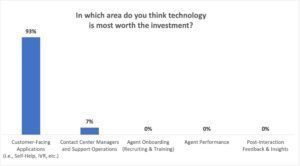In late January, Execs In The Know, in partnership with ibex, an elite outsourcer and builder of powerful customer engagement and insight solutions, hosted a select group of customer experience (CX) leaders for a Virtual Executive Roundtable. The virtual conversation focused on exploring best practices for retaining and expanding the lifetime value of customers, particularly in a time of rapid growth.
Although the discussion was wide-ranging, it often turned tactical — focusing on the various changes deployed by the different participating brands since the onset of the pandemic. Many of these changes were brought about to maintain an acceptable level of CX in a time of great challenge and uncertainty. In this post, we spotlight just a few of the changes shared, building context around those changes by highlighting the various benefits and considerations — both for businesses and their customers.

Increased Automation and Greater Reliance on Self-Service
 Automation has been on the industry’s radar for a long, long time. But the events of the past year have sped up the timeline of adoption at many organizations. In the early stages of the pandemic, lots of organizations were forced to cut staff, regardless of whether contact volumes were rising or falling. Automation rode to the rescue, acting as a release valve for frontline resources now stretched thin, while scrambling to overcome the new challenges posed by shifting entire operations to working from home.
Automation has been on the industry’s radar for a long, long time. But the events of the past year have sped up the timeline of adoption at many organizations. In the early stages of the pandemic, lots of organizations were forced to cut staff, regardless of whether contact volumes were rising or falling. Automation rode to the rescue, acting as a release valve for frontline resources now stretched thin, while scrambling to overcome the new challenges posed by shifting entire operations to working from home.
Many companies used the crisis of the pandemic to show some love to their legacy self-service systems, things like FAQs, Help Centers, and customer-facing knowledge databases. The intent was not only to try and bring down the volumes hitting live channels, but also make information more readily available to customers. The idea is simple enough — by improving access to information, less customer effort would be required to resolve an issue, and retention rates would rise. Of course, this all depends on coming up with simple and effective solutions that customers are willing to use.
Customer Benefit(s):
-
- Increased service availability, especially for transactional-type engagements
- Greater channel options
Business Benefit(s):
-
- Lower cost-per-contact
- Ability to handle more volume with less staff
- Improved CSAT and CX
Considerations:
Because automated and self-service solutions excel at handling “the easy stuff,” what’s often left over are the more complicated issues. This may call for additional training for agents and managers. It also means Average Handle Time (AHT) is likely to increase, while Customer Satisfaction (CSAT), Resolution Rates, and productivity may fall. It should also be noted that some of these shifts are much more adaptable and effective when handling business-to-consumer versus business-to-business engagements. In other words, the type of customer, and types of transactions to be handled, are definitely key considerations.
Become a Better Partner with the Product and Marketing Teams
A lot of “one-and-done” and UX- or process-related customer care issues can be headed off at the pass when internal teams are lockstep and mutually informed on new initiatives. By establishing a closer working relationship with their Product and Marketing Team counterparts, CX leaders can better predict what’s coming, while also having an opportunity to head off contact volume spikes for simple things that easily overlooked when internal visibility is obscured. Things like launches, software updates, product changes, and promotions can create contact volume surprises that are tough (if not impossible) to forecast without the right level of internal transparency and communication.
Customer Benefit(s):
-
- Avoidable customer issues, and getting caught up in volume spikes
- Get a better ownership experience
Business Benefit(s):
-
- Avoid costly volume spikes
- Increase the visibility of company initiatives
- Promote cultural alignment with the organization
- Improved CSAT and CX
Considerations:
Building stronger relationships between internal teams is a great way to promote consistency of experience across the organization, something consumers value greatly. A closer working relationship between groups also improves outcomes (for the business and its customers) and increases the successes of other multigroup projects — things like policy reviews and product launches.
Developing the Business Value of Customer Service
The days of old where contact centers were viewed strictly as cost centers are long gone. More and more, CX leaders are talking about Return on Investment (ROI) and revenue generation, as well as the standard talk of CSAT, dissatisfaction (DSAT), loyalty, etc. CX leaders can also take greater business value in their operations beyond up-selling and cross-selling. The contact center is home to a wealth of information, particularly when it comes to Voice of the Customer insights. With the rights tools in place, customer experience data can provide valuable data about what customers like and don’t like, what they want, and what triggers loyalty. All of this information can become incredibly actionable if properly compiled, analyzed, and disseminated.
Customer Benefit(s):
-
- Easier entry into the purchase funnel
- Development of new products and service based on consumer input
Business Benefit(s):
-
- Increased revenue
- Increased customer loyalty
- Gain a pipeline of insights and ideas for new offerings
Considerations:
Sales takes a particular set of skills, and these skills might not also be organically found in the contact center. For organizations that are serious about viewing every contact as a selling opportunity, specialized training is pretty much a given. Leaders should also make sure agents have all the tools and information they need to create a valuable, positive (even personalized) experience for the customers. In other words, selling in the contact center should first and foremost be about creating a better experience, with the increased revenue acting as the icing on the cake.
Placing Greater Emphasis on Metrics that are Core or Core Metrics to the Customer and the Experience
 As the industry’s Key Performance Indicators (KPIs) continue to evolve, it’s important to understand which indicators matter most to customers. Things like CSAT/DSAT are helpful, but they really measure a moment in time as opposed to the performance of an operation. On the other hand, things like customer effort, NPS, and retention rates are broader measurements that describe how customers experience a process, policy, or particular journey. This also applies to what’s being measured and monitored as a part of a Quality Assurance program. When brands understand what matters most to their customer, and then manage performance against those things, opportunities for improvement become more clear.
As the industry’s Key Performance Indicators (KPIs) continue to evolve, it’s important to understand which indicators matter most to customers. Things like CSAT/DSAT are helpful, but they really measure a moment in time as opposed to the performance of an operation. On the other hand, things like customer effort, NPS, and retention rates are broader measurements that describe how customers experience a process, policy, or particular journey. This also applies to what’s being measured and monitored as a part of a Quality Assurance program. When brands understand what matters most to their customer, and then manage performance against those things, opportunities for improvement become more clear.
Customer Benefit(s):
-
- Improved experience based on customer-centric focus
- Increased retention and loyalty
Business Benefit(s):
-
- Repositions time, energy, and resources for the best return
- Provides a clear roadmap for improving the experience
Considerations:
Along with looking at the right, customer-centric indicators, organizations should also take a close look at the journey itself. Is the journey simple, sensible, quick, and without inefficiencies? Are there common breakdowns or easily resolvable pain points? Understanding the journey from the customer’s perspective is a great way to reassess which metrics are worth prioritizing.
Like so much in CX, whether a major change or minor initiative, everything needs to start with the customer … who they are … what they want … what they need. Time and again, the roundtable conversation was joined by the phrase, “Meet your customer where they are.” This has never been truer. So whether changes are big or small, forced by necessity or a desire to do right by the customer, brands can only improve retention and build greater lifetime value by starting with the customer at the center of everything they do.
Special thanks to ibex’s John Kusak and Emmanuelle Skala from Toast for moderating this special Virtual Executive Roundtable, Driving Customer Retention & Lifetime Value While Experiencing Hyper Growth.
If you are a senior leader running CX operations on the corporate side and would like to engage your peers in a private, online community, we invite you to join our KIA online community. You can also find out about everything happening within the Execs In The Know community by joining our mailing list.
Likewise, if you are a solutions or service provider and would like to lead a future Executive Roundtable or get involved with the Execs In The Know community in other ways, you can reach out to us at info@execsintheknow.com.
Blog post, written by: Execs In The Know


